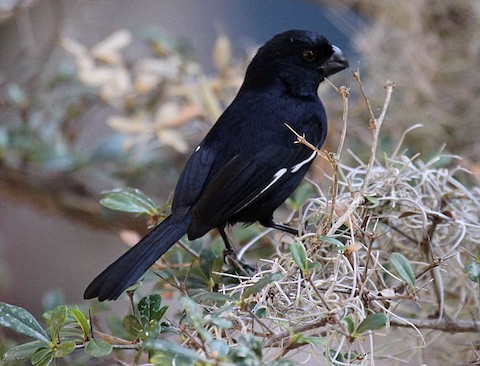Birdfinding.info ⇒ Easy to find at most of the commonly visited Cuban sites, such as Península de Guanahacabibes, Viñales, La Güira, and Topes de Collantes National Parks, the Zapata Swamp region, and Cayo Coco.
Cuban Bullfinch
Melopyrrha nigra
Endemic to Cuba and its major satellite islands, where it is widespread and common in all types of woodlands and scrub. Found throughout Cuba, Isla de la Juventud, and most of the nearby keys.
Identification
A medium-sized black bullfinch with white wing patches on the shoulders and middle primaries.

Cuban Bullfinch, male. (Salto del Guayabo, Holguín, Cuba; November 23, 2017.) © Jean-Sébastien Guénette
The sexes are similar except that males are glossy blue-black and females are dull-black.
Immatures are like adults, but have duller plumage, paler bills, and all-dark wings.

Cuban Bullfinch, male. (Cayo Paredón Grande, Ciego de Ávila, Cuba; March 17, 2017.) © R. Dennis Ringer
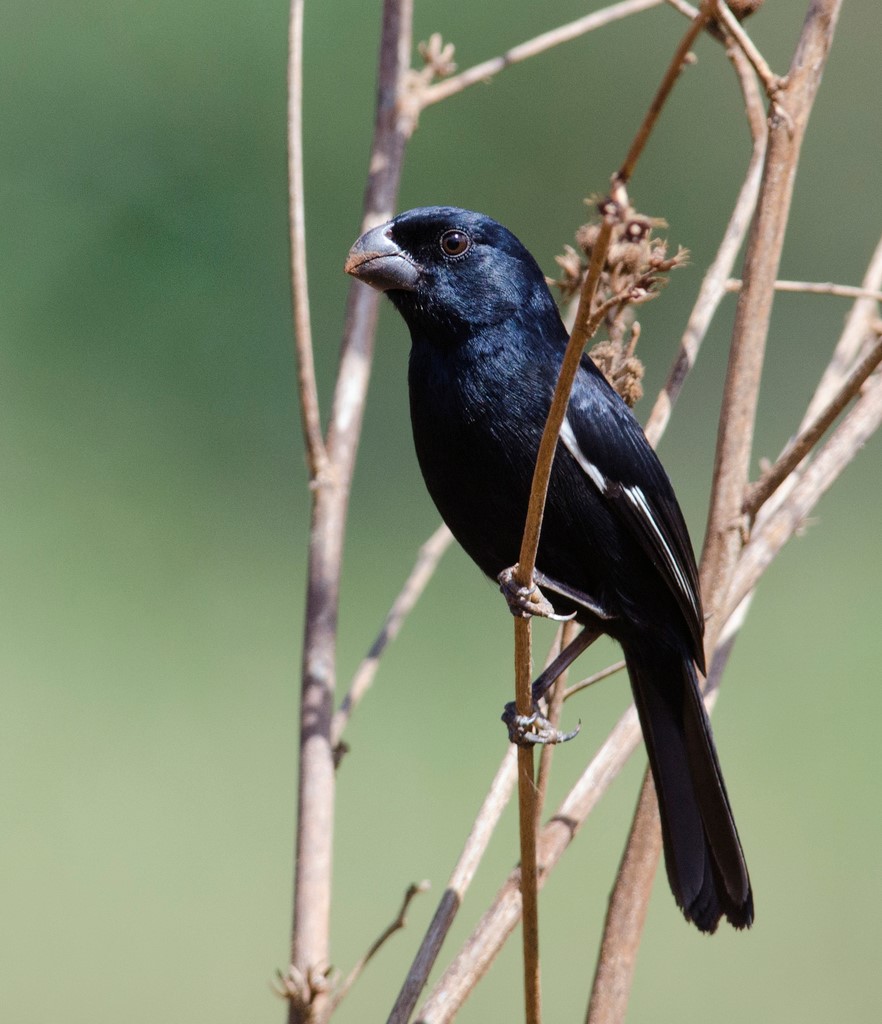
Cuban Bullfinch, male—note glossy blue-black plumage. (Viñales, Pinar del Río, Cuba; February 11, 2015.) © Joshua D. Vandermeulen

Cuban Bullfinch, male—note glossy blue-black plumage. (Cayo Coco, Ciego de Ávila, Cuba; April 1, 2015.) © Allan Hopkins

Cuban Bullfinch. (El Recreo Trail, Alejandro de Humboldt National Park, Guantánamo, Cuba; July 9, 2020.) © Roberto Jovel

Cuban Bullfinch, female. (Cayo Romano, Ciego de Ávila, Cuba; July 19, 2017.) © Andrew Dobson
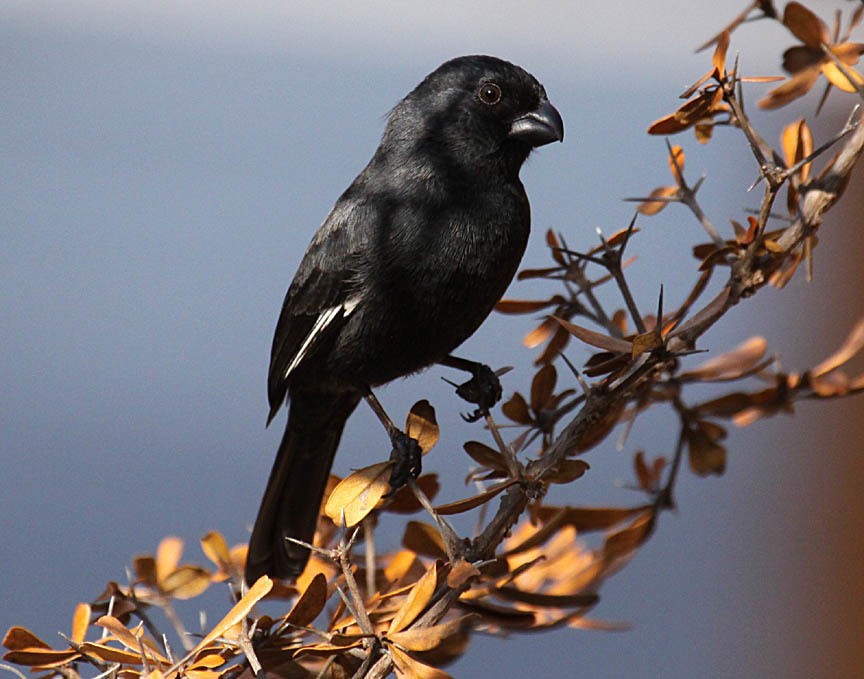
Cuban Bullfinch. (Cayo Coco, Ciego de Ávila, Cuba; March 28, 2010.) © Mark Dennis
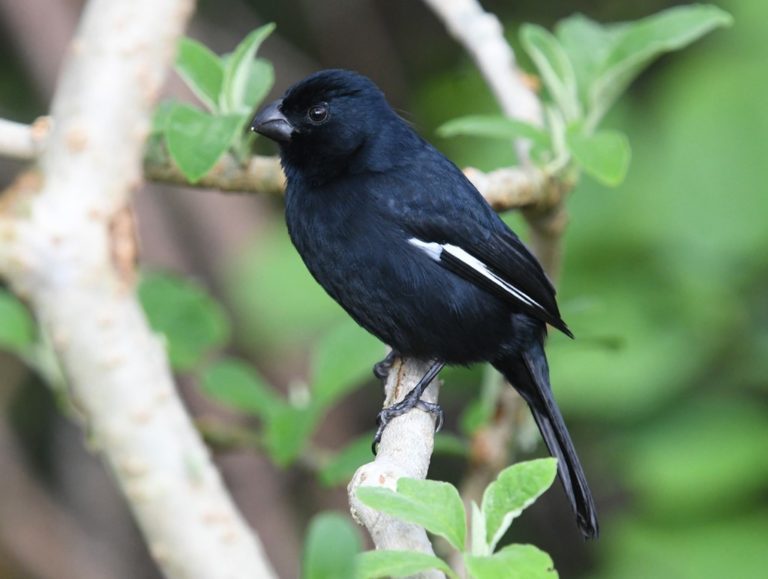
Cuban Bullfinch, male. (María la Gorda, Península de Guanahacabibes National Park, Pinar del Río, Cuba; October 28, 2018.) © Erika Simons

Cuban Bullfinch. (Cayo Coco, Ciego de Ávila, Cuba; May 4, 2013.) © William Price

Cuban Bullfinch, male. (Cayo Paredón Grande, Ciego de Ávila, Cuba; March 17, 2017.) © R. Dennis Ringer

Cuban Bullfinch, female. (Cueva del Jabali, Cayo Coco, Ciego de Ávila, Cuba; March 1, 2019.) © Arco Huang

Cuban Bullfinch, female with nesting material. (Cayo Coco, Ciego de Ávila, Cuba; May 4, 2013.) © William Price
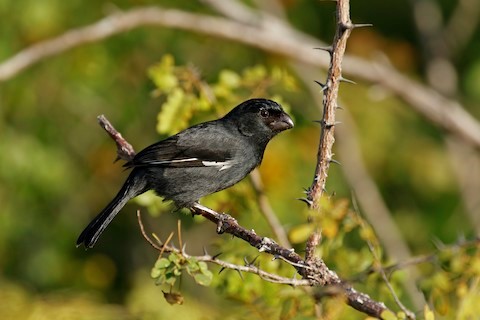
Cuban Bullfinch, female. (Cayo Coco, Ciego de Ávila, Cuba; February 24, 2019.) © Adam Bowley

Cuban Bullfinch, female. (Varadero, Matanzas, Cuba; January 17, 2019.) © Christian Grenier
Voice. Song consists of a rapid, buzzy, thin trill followed by a few quick warbled phrases: Calls are “a staccato chi-dip, and thin tsee, often repeated” (Garrido et al. 2014):
Cf. Grand Cayman Bullfinch. Cuban and Grand Cayman Bullfinches are very similar and were traditionally considered a single species until Garrido et al. (2014) published a detailed analysis of the differences between them. They do not occur together naturally, so field identification based on geographical probability is usually sufficient. However, probability alone was inconclusive for a bullfinch that appeared on Little Cayman in 2018. Following are the principal differences between Cuban and Grand Cayman Bullfinches that Garrido et al. documented:
Size: Overall, the Grand Cayman Bullfinch averages larger than Cuban in six out of seven measurements studied. Its bill, in particular, is larger than the Cuban’s in every dimension, especially in its depth (i.e., height) at the base, where it averages about 20-25% larger.
Vocalizations: The songs of Cuban and Grand Cayman Bullfinches show consistent differences in pattern and complexity. Both begin with a trill and end with warbled phrases, but Cuban’s trill is longer and more rapid, and the ending phrases are more complex than Grand Cayman’s.
Coloration: There are also differences in the plumages of both sexes. Male Cubans have glossy-black plumage with a bluish or violet sheen, whereas male Grand Cayman Bullfinches are dull-black. Females differ more distinctively: Cubans are dull-black (like male Grand Cayman), whereas female Grand Caymans are charcoal-gray with olive-brown tones. On both sexes, Grand Caymans have white on two primaries, whereas Cubans typically have white on just one primary.
Notes
Monotypic species. Traditionally regarded as conspecific with Grand Cayman Bullfinch (taylori), known collectively as the Cuban Bullfinch (nigra), but Garrido et al. (2014) show persuasive evidence that the two, although similar in most respects, are fundamentally different enough to be regarded as separate species. Their recommended split has been widely adopted.
References
BirdLife International. 2020. Pyrrhulagra nigra. The IUCN Red List of Threatened Species 2020: e.T103813101A180216283. https://dx.doi.org/10.2305/IUCN.UK.2020-3.RLTS.T103813101A180216283.en. (Accessed March 18, 2021.)
eBird. 2021. eBird: An online database of bird distribution and abundance. Cornell Lab of Ornithology, Ithaca, N.Y. http://www.ebird.org. (Accessed March 18, 2021.)
Garrido, O.H, and A. Kirkconnell. 2000. Field Guide to the Birds of Cuba. Cornell University Press.
Garrido, O.H., J.W. Wiley, A. Kirkconnell, P.E. Bradley, A. Günther-Calhoun, and D. Rodríguez. 2014. Revision of the endemic West Indian genus Melopyrrha from Cuba and the Cayman Islands. Bulletin of the British Ornithological Club 134:134-144.
Kirwan, G.M., A. Levesque, M. Oberle, and C.J. Sharpe. 2019. Birds of the West Indies. Lynx Edicions, Barcelona.
Raffaele, H., J. Wiley, O. Garrido, A. Keith, and J. Raffaele. 1998. A Guide to the Birds of the West Indies. Princeton University Press, Princeton, N.J.
Xeno-Canto. 2021. Cuban Bullfinch – Melopyrrha nigra. https://www.xeno-canto.org/species/Melopyrrha-nigra. (Accessed March 18, 2021.)
